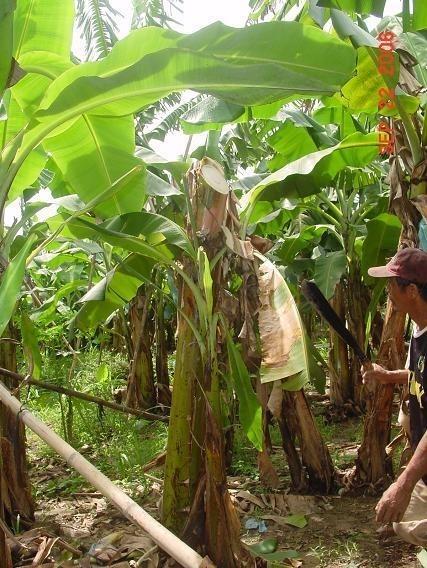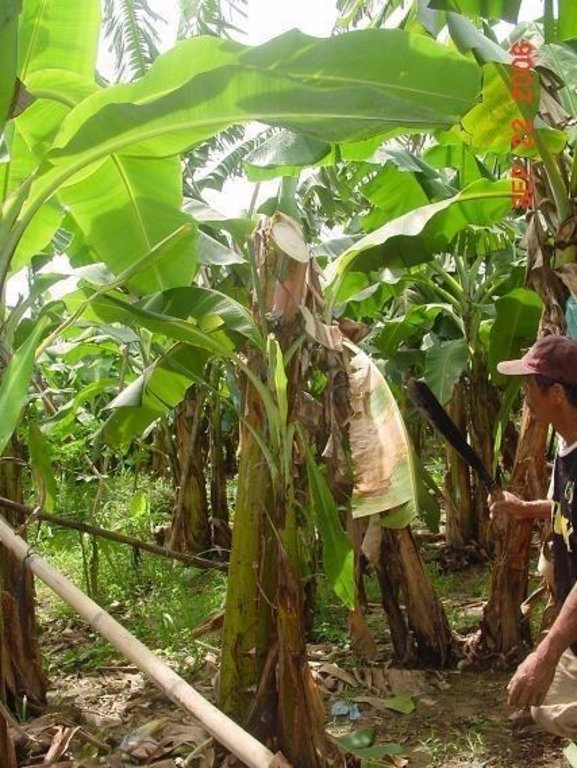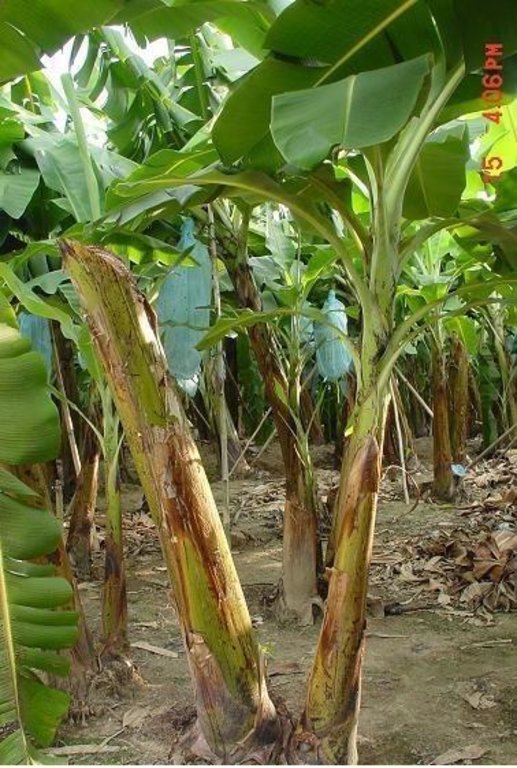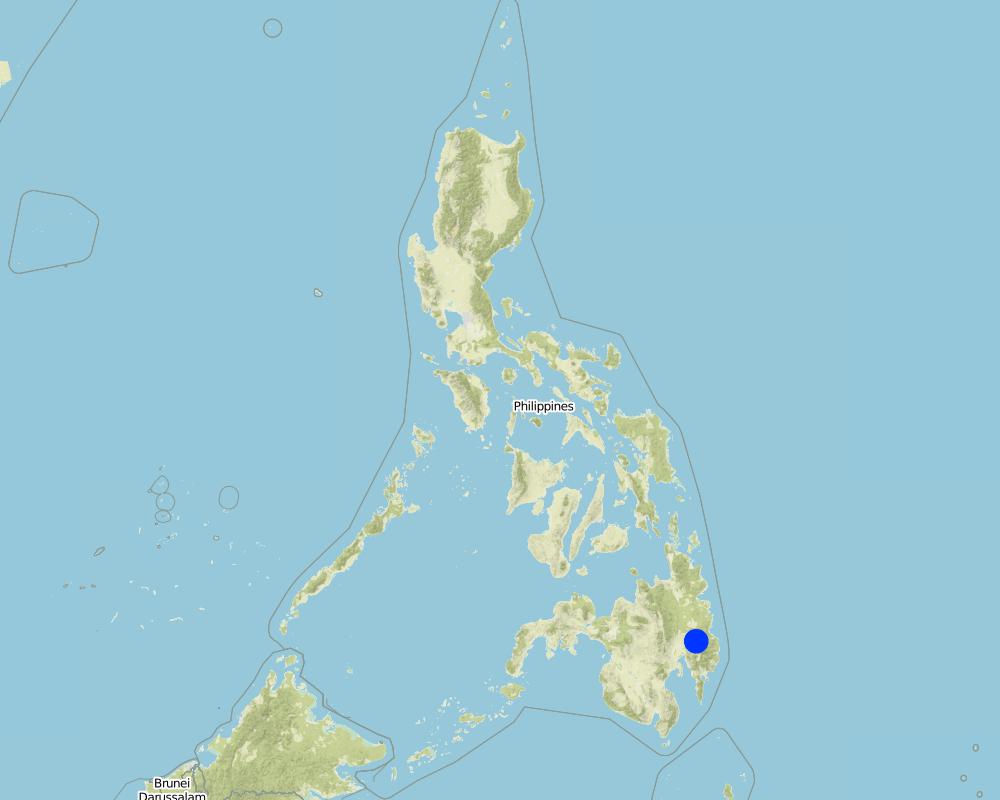In "situ" Decomposition of Banana Stalk [Philippines]
- Creation:
- Update:
- Compiler: Philippine Overview of Conservation Approaches and Technologies
- Editor: –
- Reviewers: Fabian Ottiger, Alexandra Gavilano
"Palata System"
technologies_1020 - Philippines
View sections
Expand all Collapse all1. General information
1.2 Contact details of resource persons and institutions involved in the assessment and documentation of the Technology
Key resource person(s)
SLM specialist:
SLM specialist:
Rondal Jose
Bureau of Soils and Water Management
Philippines
1.3 Conditions regarding the use of data documented through WOCAT
The compiler and key resource person(s) accept the conditions regarding the use of data documented through WOCAT:
Yes
2. Description of the SLM Technology
2.1 Short description of the Technology
Definition of the Technology:
Leaving the trunk of a newly harvested banana standing beside a follower plant to provide nutrients and moisture especially during period of drought.
2.2 Detailed description of the Technology
Description:
Traditionally, banana is cut at the base (ground level) during harvesting and the stem is used as mulch. This has been the practice of the banana plantations for many years. Lately however, it was found out by research that by leaving the trunk standing beside a follower plant, yield could be improved because the trunk contains nutrients and moisture which could be used by the succeeding plants. The banana crown is cut just below the fruit and the leaves used as mulch. After a few months the trunk disintegrates and decomposes and the follower plants grow unimpeded utilizing the nutrients and moisture contained in the decomposing trunk..
2.3 Photos of the Technology
2.5 Country/ region/ locations where the Technology has been applied and which are covered by this assessment
Country:
Philippines
Further specification of location:
Davao del Norte, Maguindanao, Comval Province
Specify the spread of the Technology:
- evenly spread over an area
If the Technology is evenly spread over an area, specify area covered (in km2):
14.0
Comments:
Total area covered by the SLM Technology is 14 km2.
Map
×2.7 Introduction of the Technology
Specify how the Technology was introduced:
- during experiments/ research
3. Classification of the SLM Technology
3.2 Current land use type(s) where the Technology is applied

Cropland
- Perennial (non-woody) cropping
Perennial (non-woody) cropping - Specify crops:
- banana/plantain/abaca
Specify:
Longest growing period in days: 270 Longest growing period from month to month: May - Feb
Comments:
Major land use problems (compiler’s opinion): Large requirement of banana for nutrients and moisture which is insufficient during period of drought.
Major land use problems (land users’ perception): Decreasing yield due to nutrient depletion and the frequent occurrence of drought
3.4 Water supply
Water supply for the land on which the Technology is applied:
- full irrigation
Comments:
Water supply: mixed rainfed - irrigated, full irrigation
3.5 SLM group to which the Technology belongs
- agroforestry
- water harvesting
- Improoving yield by leaving the trunk of a harvested plant stand beside a follower plant
3.6 SLM measures comprising the Technology

agronomic measures
- A2: Organic matter/ soil fertility
Comments:
Main measures: agronomic measures
Type of agronomic measures: manure / compost / residues
3.7 Main types of land degradation addressed by the Technology

chemical soil deterioration
- Cn: fertility decline and reduced organic matter content (not caused by erosion)

water degradation
- Ha: aridification
Comments:
Main type of degradation addressed: Cn: fertility decline and reduced organic matter content, Ha: aridification
3.8 Prevention, reduction, or restoration of land degradation
Specify the goal of the Technology with regard to land degradation:
- reduce land degradation
- restore/ rehabilitate severely degraded land
Comments:
Main goals: mitigation / reduction of land degradation, rehabilitation / reclamation of denuded land
4. Technical specifications, implementation activities, inputs, and costs
4.1 Technical drawing of the Technology
Technical specifications (related to technical drawing):
Date: 9-15-2006
Technical knowledge required for field staff / advisors: low
Technical knowledge required for land users: low
Main technical functions: increase / maintain water stored in soil, increase in soil fertility
Manure / compost / residues
Material/ species: trunk of harvested banana
Quantity/ density: 2,200 plan
Remarks: In rows
Author:
Jose D. Rondal
4.2 General information regarding the calculation of inputs and costs
Indicate average wage cost of hired labour per day:
5.00
4.5 Maintenance/ recurrent activities
| Activity | Timing/ frequency | |
|---|---|---|
| 1. | Cutting of crown of newly harvested plant | harvest time / annual |
4.6 Costs and inputs needed for maintenance/ recurrent activities (per year)
| Specify input | Unit | Quantity | Costs per Unit | Total costs per input | % of costs borne by land users | |
|---|---|---|---|---|---|---|
| Labour | person-days | 1.0 | 50.0 | 50.0 | 100.0 | |
| Equipment | Tools | 1.0 | 10.0 | 10.0 | 100.0 | |
| Total costs for maintenance of the Technology | 60.0 | |||||
| Total costs for maintenance of the Technology in USD | 60.0 | |||||
Comments:
Machinery/ tools: 5 big knives
4.7 Most important factors affecting the costs
Describe the most determinate factors affecting the costs:
Based on the plant population per hectare.
5. Natural and human environment
5.1 Climate
Annual rainfall
- < 250 mm
- 251-500 mm
- 501-750 mm
- 751-1,000 mm
- 1,001-1,500 mm
- 1,501-2,000 mm
- 2,001-3,000 mm
- 3,001-4,000 mm
- > 4,000 mm
Specify average annual rainfall (if known), in mm:
2500.00
Specifications/ comments on rainfall:
When El Nino occurs (abnormally low rainfall from 1001-1500mm)
Agro-climatic zone
- humid
- sub-humid
Thermal climate class: tropics
5.2 Topography
Slopes on average:
- flat (0-2%)
- gentle (3-5%)
- moderate (6-10%)
- rolling (11-15%)
- hilly (16-30%)
- steep (31-60%)
- very steep (>60%)
Landforms:
- plateau/plains
- ridges
- mountain slopes
- hill slopes
- footslopes
- valley floors
Altitudinal zone:
- 0-100 m a.s.l.
- 101-500 m a.s.l.
- 501-1,000 m a.s.l.
- 1,001-1,500 m a.s.l.
- 1,501-2,000 m a.s.l.
- 2,001-2,500 m a.s.l.
- 2,501-3,000 m a.s.l.
- 3,001-4,000 m a.s.l.
- > 4,000 m a.s.l.
Comments and further specifications on topography:
Altitudinal zone: 0-100 m a.s.l. (Banana plantations are in the lowland)
Landforms: plateau/plains (Mostly coastal and alluvial plains)
Slopes: flat and gentle (All commercial banana plantations are on level land)
5.3 Soils
Soil depth on average:
- very shallow (0-20 cm)
- shallow (21-50 cm)
- moderately deep (51-80 cm)
- deep (81-120 cm)
- very deep (> 120 cm)
Soil texture (topsoil):
- medium (loamy, silty)
- fine/ heavy (clay)
Topsoil organic matter:
- high (>3%)
- medium (1-3%)
If available, attach full soil description or specify the available information, e.g. soil type, soil PH/ acidity, Cation Exchange Capacity, nitrogen, salinity etc.
Soil depth: very deep >120cm ( Soils are alluvium-derived, hence, very deep )
Soil texture: medium (loamy, silty) and fine/heavy (clay) (loamy because of the influence of river alluvium )
Soil fertility is low: Natural fertility is depleted due to continuous cropping
Topsoil organic matter: medium (1-3%) and high (>3%) (Depleted due to long period of intensive use )
Soil drainage/ infiltration is good to medium (Loamy soils with good permeability)
Soil water storage is medium to low (Not much clay and organic matter)
5.6 Characteristics of land users applying the Technology
Off-farm income:
- > 50% of all income
Relative level of wealth:
- average
- rich
Level of mechanization:
- manual work
- mechanized/ motorized
Indicate other relevant characteristics of the land users:
Population density: 50-100 persons/km2
60% of the land users are rich and own 60% of the land (Multi-national company).
40% of the land users are average wealthy and own 40% of the land (Land owners/growers).
Off-farm income specification: For small time growers, they work in the banana processing plant. For some, their children have other employment, either locally or abroad.
Level of mechanization: Land preparation
5.7 Average area of land used by land users applying the Technology
- < 0.5 ha
- 0.5-1 ha
- 1-2 ha
- 2-5 ha
- 5-15 ha
- 15-50 ha
- 50-100 ha
- 100-500 ha
- 500-1,000 ha
- 1,000-10,000 ha
- > 10,000 ha
Comments:
Size of cropland for households: 2-5ha
Size of cropland for companies 500-100ha
5.8 Land ownership, land use rights, and water use rights
Land ownership:
- company
- individual, titled
Land use rights:
- leased
- individual
6. Impacts and concluding statements
6.1 On-site impacts the Technology has shown
Socio-economic impacts
Production
crop production
Comments/ specify:
little (5-20%) - Practice is just a few years old
Income and costs
farm income
Comments/ specify:
medium (20-50%) - Due to decrease in fertilizer input
Ecological impacts
Soil
soil moisture
Comments/ specify:
just at the base of the follower plant
Other ecological impacts
increase in soil fertility
Comments/ specify:
little (5-20%) - Just at the base of the follower plant
6.4 Cost-benefit analysis
How do the benefits compare with the establishment costs (from land users’ perspective)?
Short-term returns:
slightly positive
Long-term returns:
slightly positive
How do the benefits compare with the maintenance/ recurrent costs (from land users' perspective)?
Short-term returns:
slightly positive
Long-term returns:
slightly positive
6.5 Adoption of the Technology
- > 50%
If available, quantify (no. of households and/ or area covered):
100 land user families/households
Of all those who have adopted the Technology, how many did so spontaneously, i.e. without receiving any material incentives/ payments?
- 51-90%
Comments:
70% of land user families have adopted the Technology without any external material support
100 land user families have adopted the Technology without any external material support
Comments on spontaneous adoption: estimates
There is a moderate trend towards spontaneous adoption of the Technology
Comments on adoption trend: The beneficial effect has been proven in increasing yield and in input cost reduction.
6.7 Strengths/ advantages/ opportunities of the Technology
| Strengths/ advantages/ opportunities in the land user’s view |
|---|
|
Easy to apply and practically no added cost How can they be sustained / enhanced? Sustained IEC |
| Strengths/ advantages/ opportunities in the compiler’s or other key resource person’s view |
|---|
|
Easy to apply How can they be sustained / enhanced? Sustained IEC |
6.8 Weaknesses/ disadvantages/ risks of the Technology and ways of overcoming them
| Weaknesses/ disadvantages/ risks in the land user’s view | How can they be overcome? |
|---|---|
| Perpetuation of disease for affected plants. | Plant eradication. |
| Weaknesses/ disadvantages/ risks in the compiler’s or other key resource person’s view | How can they be overcome? |
|---|---|
| It could be a way by which pests and diseases multipl. | Burning or proper disposal of plants affected by disease. |
7. References and links
7.1 Methods/ sources of information
Links and modules
Expand all Collapse allLinks
No links
Modules
No modules





